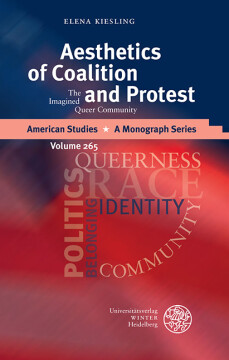
BUCH
Aesthetics of Coalition and Protest
The Imagined Queer Community
American Studies – A Monograph Series, Bd. 265
2015
Zusätzliche Informationen
Bibliografische Daten
Abstract
This volume examines identity and community through the intersection of queerness and race. The growing incorporation of white queer subjects into the socio-cultural and political landscape of the U.S. results in the usage of the queer community as a marker of progressiveness for the nation and in an increasing centrality of whiteness within the community and its surrounding politics. Can this queer community still undermine existing normative structures of whiteness and heteronormativity or does it simply reinforce them through universalizing queerness for the sake of legal and social reform that ultimately benefit only a few? Through the analysis of queer of color film, this book imagines the possibility of a pan-ethnic queer community, while simultaneously questioning the juxtaposition of a de-essential/anti-identity concept like queer and an essential concept like community. It troubles the intersection of queerness and race and even intersectionality itself.
Inhaltsverzeichnis
| Zwischenüberschrift | Seite | Aktion | Preis |
|---|---|---|---|
| Cover | C | ||
| Title Page | 3 | ||
| Copyright | 4 | ||
| Table of Contents | 5 | ||
| 1 Introduction | 9 | ||
| 1.1 Introducing the Queer Community | 12 | ||
| 1.1.1 Is a Pan-Ethnic Queer Community Possible? | 15 | ||
| 1.1.2 Community, Identity, and the Nation | 25 | ||
| 1.1.3 The Social, the Cultural, and the Political | 26 | ||
| 1.2 Research in the Borderlands | 28 | ||
| 1.2.1 Community Studies | 31 | ||
| 1.2.2 Visual Cultural Studies | 36 | ||
| 1.2.3 Transnational American Studies | 38 | ||
| 1.2.4 Multiple Identity —Racializing Queerness/ Queering Race | 39 | ||
| 1.2.4.1 Ethnic Studies | 40 | ||
| 1.2.4.2 Women of Color Feminism | 43 | ||
| 1.2.4.3 Critical Whiteness Studies | 44 | ||
| 1.2.5 Queer Studies | 45 | ||
| 1.2.5.1 Queerness and Identity | 50 | ||
| 1.2.5.2 Queerness as Anti-Normative | 52 | ||
| 1.2.5.3 Queerness and Sexual Politics | 54 | ||
| 1.3 Structural Overview | 60 | ||
| 2 Multiple Identity and the Performance of Community | 63 | ||
| 2.1 Idea(l)s of Community | 69 | ||
| 2.2 The Performance of Community | 72 | ||
| 2.2.1 Limited Notions of Identity and Community: Black Is…Black Ain’t | 72 | ||
| 2.2.2 Citizenship, Belonging, and Collective Memory in Milind Soman Made Me Gay | 79 | ||
| 2.2.3 Silent Erasure in Between Places | 89 | ||
| 2.3 Community as Assemblage | 93 | ||
| 3 Aesthetics of Coalition and Protest | 97 | ||
| 3.1 The Complexity of Change | 97 | ||
| 3.2 Queer Film | 106 | ||
| 3.2.1 Queer of Color Film | 107 | ||
| 3.2.2 Queer Film Festivals and Community | 109 | ||
| 3.2.3 Film Material | 113 | ||
| 3.3 Memory, Identity, and Community | 119 | ||
| 3.3.1 Collective Memory and Multiple Identity | 124 | ||
| 3.3.2 Queer Ethnic Memory in Brother to Brother | 131 | ||
| 3.3.2.1 The Unintended Audience | 134 | ||
| 3.3.2.2 Narratives of the Past | 136 | ||
| 3.3.2.3 Richard Bruce Nugent | 139 | ||
| 3.3.2.4 Black Queer Identity in “Smoke, Lilies and Jade” | 140 | ||
| 3.3.2.5 The Hierarchization of Identity | 142 | ||
| 3.4 Non-Traditional Gender and Sexuality in The Aggressives | 151 | ||
| 3.4.1 Documenting The Aggressives | 158 | ||
| 3.4.2 Complex Identifications | 160 | ||
| 3.4.3 The Invisibility of Blackness | 162 | ||
| 3.4.4 Black (Female) Masculinity | 166 | ||
| 3.4.5 Colorblindness | 170 | ||
| 3.4.6 Realness | 174 | ||
| 3.4.7 Creating Community | 177 | ||
| 3.4.7.1 Belonging | 180 | ||
| 3.4.7.2 Queer Diaspora | 182 | ||
| 3.4.7.3 Alternative Communities | 184 | ||
| 3.5 Wild Alliances | 187 | ||
| 3.5.1 Wildness—the Party and Movie | 188 | ||
| 3.5.2 Queer Ethnography | 194 | ||
| 3.5.3 Safe Spaces | 201 | ||
| 3.5.4 Critical Trans Politics | 206 | ||
| 3.5.5 Negotiating Safe Space, Community, and Identity | 213 | ||
| 3.5.6 Beyond Wildness | 220 | ||
| 3.5.7 Coalition Through Difference | 226 | ||
| 4 Conclusion | 227 | ||
| List of Works Cited | 243 |


 Publishing Platform by CloudPublish
Publishing Platform by CloudPublish